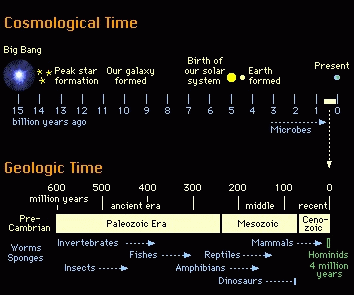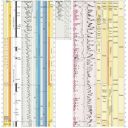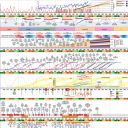
| Palaeos: |  |
Time |
| Time | Time |
| Page Back: Sitemap | Unit Up: Palaeos home | Unit Home (you are here) |
Page Next: Deep Time |
| Top Unit Back: Palaeos home | Unit Down: Geological Time | Unit Down/Next: Cosmological time Timescales |
Top Unit Next: Cosmic Evolution Sister Unit |
|
Cosmological time Geological Time Quaternary Time Historical Time Future Time |
Deep Time Logarithmic Timescales Cosmic Calendar Geological Timescales |
This unit is one of the two starting points for the new Palaeos, the other being cosmic evolution.
In order to understand the evolution of life, the Earth, and the cosmos as a whole, we need to understand deep time. In other words, it is necessary to think in terms of millions, tens or hundreds of millions, or even billions of years. Geologists pioneered the discovery of Deep Time in the 18th and 19th century, overthrowing the ridiculously short biblical timescales that were standard until then. Their work was further taken up by astronomers and physicists speculating on the age of the universe.
 Cosmic time-line. Image from Juliet Bennett's Blog, original source unknown. This timeline shows two scales of deep time:cosmological time, here measured in billions of years, and geological time, measured in hundreds of millions. Other logarithmic scales could be shown as well. |
In describing big history, the history and evolution of life, the universe, and everything, a number of distinct but overlapping types and scales of timeline are often posited. Among these are Cosmological time, Geological Time, Quaternary Time, and Historical Time. Of these, we only go into detail regarding geological time, as this is the one that is most relevant to (and used to define) the major stages in the history of life on Earth. The other two timescales are given only a very cursory review.
In the diagram on the left, there are two timescales which overlap, cosmological and geological time. Then right at the very end we could have a very brief further one, archeological time, from the Lower Palaeolithic (old stone age) onwards. History doesn't even figure at this scale.
The only way to integrate all of these different timescales, the five thousand years of recorded history and five billion years of Earth history, and even for that matter the 13.7 (or perhaps longer, as there are stars that seem to be older than that age see however link link) cosmological timeline and what you did yesterday, in a single scale is to use a Logarithmic Timeline. Most of Palaeos however, especially when we get the history of life and of the Earth, is based on the middle of this spectrum, generally five or ten million or so year intervals, although in some instances such as the Cenozoic it is possible to get down to a reliable one million year resolution. MAK110725, 110915
The following gives a brief overview of some of the various possible timescales:

Cosmological time
Cosmological time is logarithmic; it begins with the postulated unimaginably short moments of, and immediately following, the Big Bang, then becomes more sedate as the universe expands and things slow down. Finally it settles down to a leisurely rate of billions of years. Scientists have even postulated trillions upon trillions of future years in which all the stars slowly go out, a rather bleak prospect which does not take into account various other factors such as alternative cosmologies and possible future space-time engineering technology. For now, Cosmic Time is defined as the period from the origin of the known universe (the "Big Bang") to the present, a period of some 13.7 billion years (or 137 geons), and is considered to extend an indefinite but finite number of gigayears into the future.
|

Geological Time
Geological Time encompasses four and a half billion years of Earth History, and is divided into eons, eras, periods, epochs, and so on. Five aeons are postulated here: the Chaotian, Hadean, Archean, Proterozoic, and Phanerozoic eons. Of these, the Chaotian was the shortest, but also in a sense the most important, because that's when the Solar System was formed. Then for the next three eons, which make up almost the whole history of the Earth, nothing happened except for microbes swimming around the primordial ocean. Finally, following an extraordinary coincidence of events such as a really big ice age (Snowball Earth), the break-up of a supercontinent (called Rodinia) a rise in oxygen, and change in ocean chemistry, complex life suddenly emerged, the result being the Cambrian explosion and the start of the Phanerozoic. From the Cambrian to now was little more than a tenth of the age of the Earth and Solar System. Yet so much happens that we need finer divisions, and eons, eras and geons are replaced by eras (the famous Paleozoic, Mesozoic, and Cenozoic), periods, epochs, ages, -and megayears. Hence the story of the succession of all sorts of amazing plants and animals, documented herein.
|

Quaternary Time
Between the megayear expanses of Geological Time, the drift of continents, and the rise and fall of dynasties of life, and the mere centuries of Historical Time, with its own rise and fall of dynasties of nations and civilisations, there is an intermediate region that we don't really cover in great detail here, but is still interesting nevertheless. That is Quaternary Time, which covers the two million or so years of paleoclimatology, paleoanthropology, paleontology, and archeology from the Plio-Pleistocene to the current Holocene, using divisions of time on the scale of millennia and tens of millennia. This timescale is relevant to studies on medium term climate fluctuations and their ecological effects. From our anthropocentric perspective, paleolithic human migrations and the origin and early evolution of human language and culture, all pertain to this timescale. |

Historical Time
Historical Time is, well, about history. Everything from the beginnings of the city-state and civilization in the Chalcolithic through to Bronze Age Near and Middle East, social innovations as commerce, monarchy, the church, and the standing army, the rise and fall of empires, the invention of the printing press, the steam engine and the industrial revolution. As with geological time there seems to be a sort of exponential acceleration, with lots of things happening in the twentieth century, and even more with the information revolution and the global noosphere of the internet. According to transhumanists we're heading for a technological singularity, although we have already passed peak oil. With the way resources are being consumed and species exterminated, it is clear we've reached the end of nature, and perhaps the end of history. Which brings us to...
|
 Future Time
Although the future is unpredictable and remains to be determined, four possible stylised outcomes are listed here for the near-term, each of which will have implications for the longer term. These are - postapocalypse (out with a bang, equivalent or even worse than the P-T mass extinction), long decline (out with a wimper), ecotopia (the best of all possible worlds from our present knowledge), and singularity (the evolution of radical new "kingdom", totally transcending humanity and current life on Earth). All of which implies very different timescales of course.
|
A few links: James Childs Universe - a large number of post-like diagrams, based on the general theme of cosmic evolution; Niel Brandt's Timelines and Scales of Measurement Page includes a number of timelines and scales, including logarithmic, historical, etc, which together encompass a big history / cosmic evolution approach; Universe Timeline by Alexander Kozik - what it says.
| Page Back: Sitemap | Unit Home (you are here) |
Page Top | Page Next: Deep Time |
content by MAK110725, MAK110915, edited RFVS111108